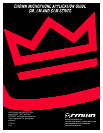
Orchestra, Band, Choir, or Organ
Recording (Figure 15):
• Hang or place two GLM-100, CM-700 or CM-150
mics about 10 feet apart, about 14 feet above the
floor, and 5 to 15 feet in front of the front-row
musicians.
• Using a stereo mic adapter, hang or place two
CM-700 mics in a coincident or near coincident
arrangement. Place the pair about 14 feet above the
floor, and 5 to 15 feet in front of the front-row
musicians.
• See the Crown Boundary Mic Application Guide for
more suggestions. The SASS is especially useful for
this application.
Reinforcement:
• For sound reinforcement of an orchestra or band,
mike each section separately a few feet away with a
GLM-100, CM-30, or CM-31. Keep in mind the 3:1
rule to prevent phase interference: The distance
between microphones should be at least three times
the distance from each microphone to its sound
source.
Choir (Figure 16):
Reinforcement:
• To reinforce a choir, use two CM-30 or CM-31
microphones, spaced to divide the choir in thirds.
Hang them 18 inches in the front row, 18 inches over
the head height of the back row. Angle them down to
aim at the back row.
• To keep each microphone from rotating, you might
want to thread some fishing line through the tiny
pipe or crossbar on the hanger. Attach the line to the
side walls, about a foot below the height of the
microphone in order to provide a downward pull.
• Use two CM-700s on stands.
News and sports reporting
Studio:
• Clip a miniature omni microphone to the
shirt about 8 inches under the chin. Since the
camera sees it on-edge, it looks like a tie bar, not a
microphone.
12
How to reduce the phase
cancellations between two mics
If two microphones pick up the same sound source
at different distances, and their signals are fed to the
same channel, this might cause phase cancellations.
These are peaks and dips in the frequency response
caused by various frequencies combining out-of-
phase. The result is a colored, filtered tone quality.
To reduce phase cancellations between two micro-
phones:
• Mike close.
• Spread instruments farther apart.
• Follow the 3 to 1 rule (Figure 3): The distance
between mics should be at least three times the mic-
to-source distance. For example, if two microphones
are each 1 foot from their sound sources, the mics
should be at least 3 feet apart to prevent phase
cancellations.
• Don’t use two mics when one will do the job. For
example, use just one mic on a lectern. If the talker
wanders, use a lavalier mic instead, such as the
CM-10.
How to reduce phase cancellations
from surface reflections
Sometimes you must place a microphone near a hard
reflective surface. Situations where this might occur
are reinforcing drama, musicals, or opera with the
microphones near the stage floor, recording a piano
with the mic near the raised lid, or recording an
instrument surrounded by reflective baffles.
As described in the Crown Boundary Mic Application
Guide, these situations can cause phase cancellations
which give a strange tone quality. Solve the problem
by using Crown PZM or PCC microphones mounted
to the piano lid, wall, floor, or other large flat surface.
How to reduce handling noise
and stand thumps
• Use an omnidirectional microphone such as a
CM-10 or any PZM.
• Use a directional microphone with low sensitivity to
handling noise and thumps, such as the CM-200A,
CM-310A, or any PCC.
• Use a directional microphone with an internal shock
mount.
• Use a shock-mount stand adapter on a mic stand.
• Place the mic stand on foam or sponges.
How to reduce proximity effect
Proximity effect is the bass boost you hear when you
mike close with a single-D directional microphone.
“Single-D” means that the microphone has a single
distance from its front sound entry to the rear sound
entry. The closer the mic is to the sound source, the
more bass you hear. To reduce proximity effect:
• Use an omni directional microphone.
• Turn down the excess bass with your mixer’s EQ.
How to reduce pop
Pop is an explosive breath sound produced by the
letters “p”, “b”, or “t”. When a person says words
containing these sounds, a turbulent puff of air is
forced from the mouth. This air puff hits the micro-
phone and makes a thump or little explosion called a
“pop”.
To reduce pop:
• Use an omnidirectional microphone.
• Use a microphone with a built-in pop filter or ball
shaped grille, such as the Crown CM-200A or
CM-310A.
• Place an external foam pop filter on the microphone.
• Place the microphone out of the path of pop travel -
above, below, or to the side of the mouth.
• Roll off low frequencies below 100 Hz.
5
















